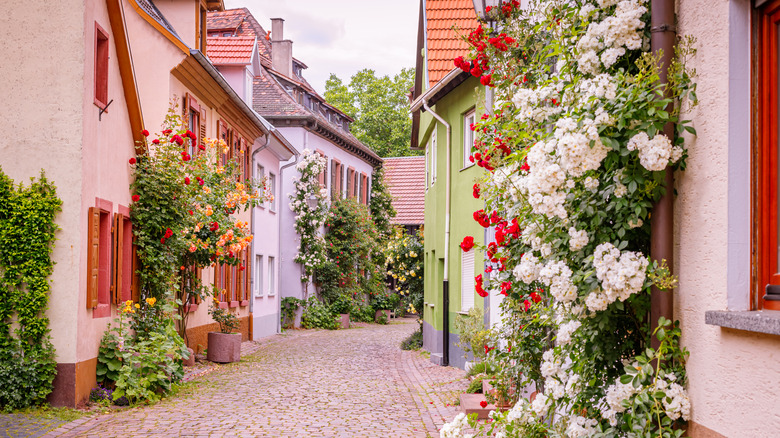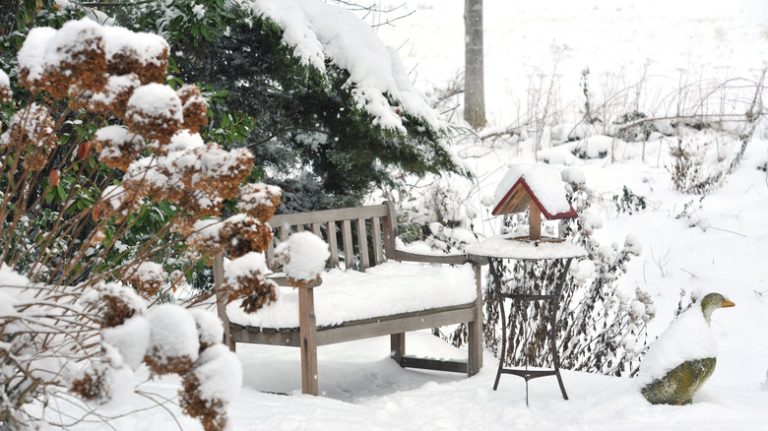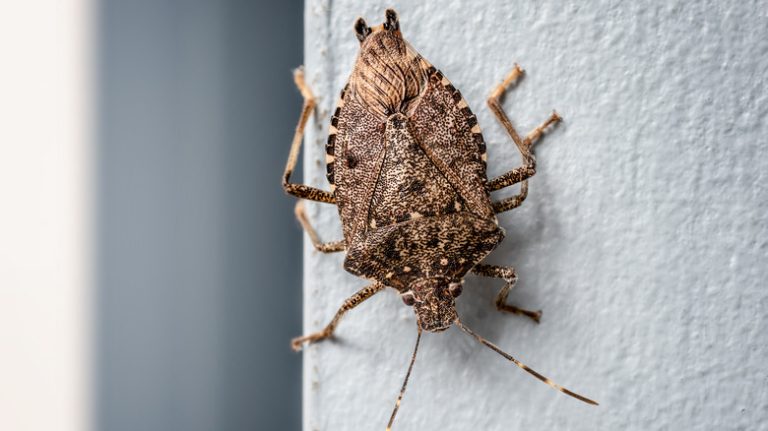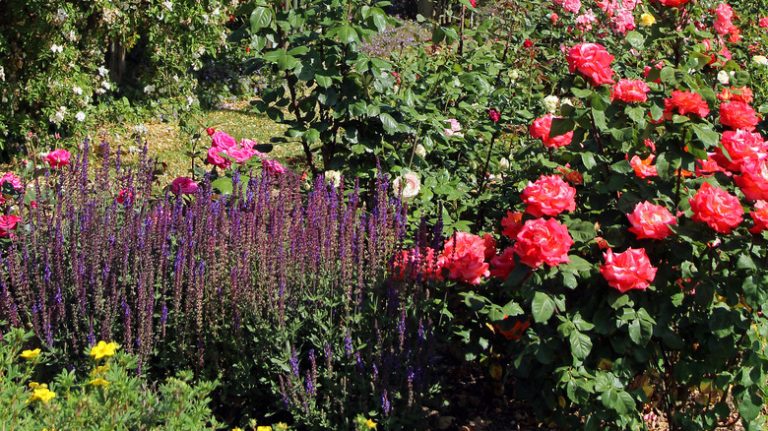Climbing roses, also known as ramblers, are proof that nature is an incomparable architect and perfumer. These woody perennial flowering plants are the acrobats of the rosa family, well-known for contorting around arbors, walls, pillars, trellises, gazebos, and pergolas. They typically bear large, stunning foliage that intensifies the vibrancy, beauty, and design of a home. Apart from the cosmetic advantages, there are functional reasons for planting ramblers. Stark Bro’s Nurseries & Orchards Co. explains that since they have stiff, upright, extra-long canes, you can manipulate the stems to act as screens and doorway frames.
As you’re getting ready to embark on your climbing rose journey, we recommend that you purchase disease-resistant varieties and repeat-bloomers. They tend to be easy to work with and profusely bloom when planted horizontally instead of vertically. So without further ado, let’s get into the ramblers that can transform your home into an enchanting cottage in no time.
1. Rosa ‘Pippin’
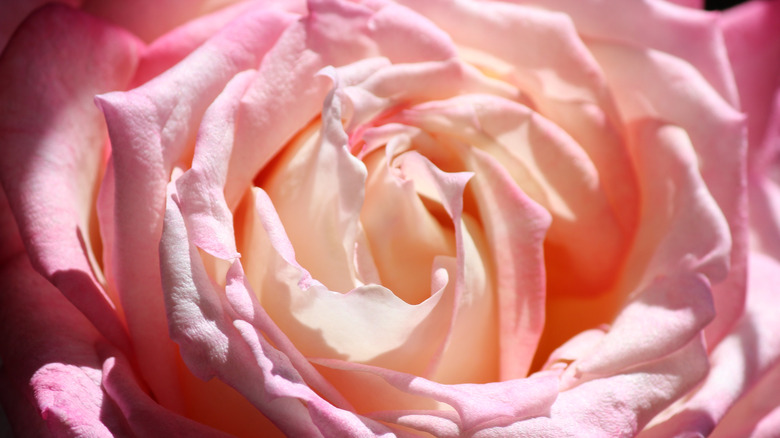
To fully appreciate the beauty and delicate, sweet fragrance of Rosa ‘Pippin’ (Rosa ‘Pippin’), plant them around your garden seating area, experts at the National Gardening Association suggest. Your guests will enjoy its colorful blooms and glossy foliage throughout the seasons.
Bloom Season: Spring, summer, fall
USDA Growing Zone: 5 to 9
Growing Conditions: Full sun, dappled shade
Soil Type: Moist, well-draining; tolerate most soil types
Size: 7 to 8 feet tall, 3 to 4 feet wide
2. Highwire flyer
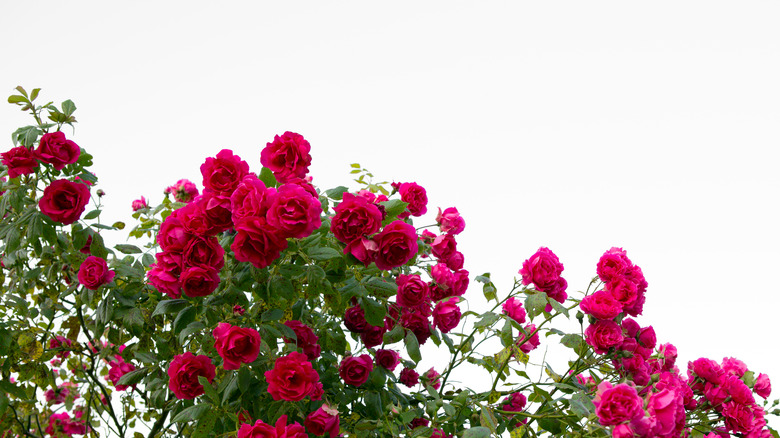
The highwire flyer (Rosa ‘Highwire Flyer’) deserves a spot in your garden for its vibrant, hot pink blooms alone. The celebrated breeder, Will Radler, introduced this climber in 2024, and it has since become one of the most stunning climbing roses in the U.S., notes Star Roses and Plants. Highwire flyer is easy to grow and highly resistant to mildew, rust, and black spot.
Bloom Season: Spring, summer, fall
USDA Growing Zone: 4 to 11
Growing Conditions: Full sun
Soil Type: Rich loam, well-draining
Size: 6 to 8 feet tall, 3 to 4 feet wide
3. Altissimo
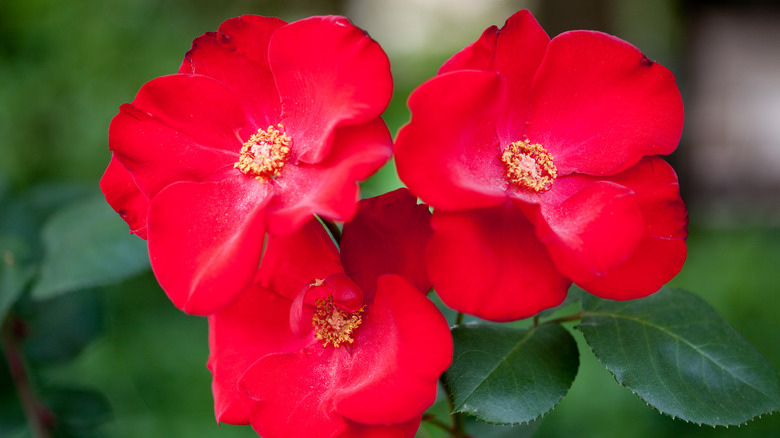
Sann von Mai/Shutterstock
Make a bold statement in your front yard landscaping with Altissimo (Rosa ‘Altissimo’), the dazzling red climbing rose with yellow stamens. Altissimo flowers freely and repeatedly, complimenting landscapes, walls, fences, and pergolas, via Gardenia. We appreciate how it tolerates poor soils and attracts pollinators like butterflies and bees.
Bloom Season: Summer through late fall
USDA Growing Zone: 5 to 10
Growing Conditions: Full sun, regular waterings
Soil Type: Moist, well-draining
Size: 7 to 20 feet tall, 5 to 8 feet wide
4. New dawn
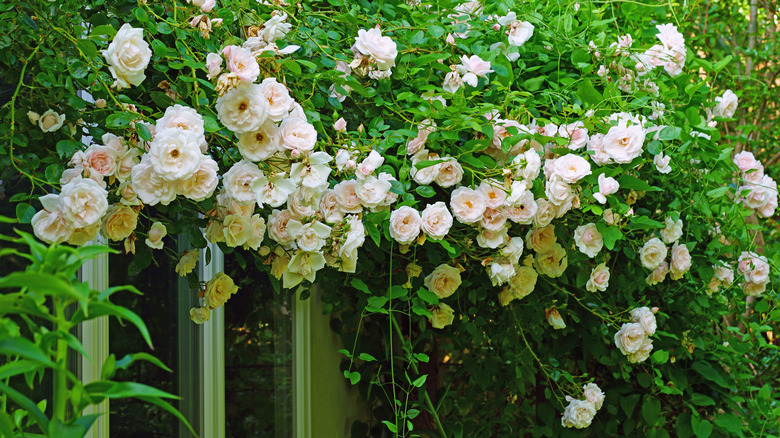
EQRoy/Shutterstock
New dawn (Rosa ‘New Dawn’) is so fast-growing that it reaches maturity within two seasons. If you’re looking to start pergola training or refresh your landscape with a splash of large pink blooms, this is one of the best climbing roses to purchase. It quickly stretches across fences and trellises, and gives off a fruity apple fragrance, per Great Garden Plants.
Bloom Season: Summer to late fall
USDA Growing Zone: 5 to 9
Growing Conditions: Full sun to partial shade
Soil Type: Acidic, moist, well-draining
Size: 10 to 15 inches high, 6 to 10 inches wide
5. Iceberg
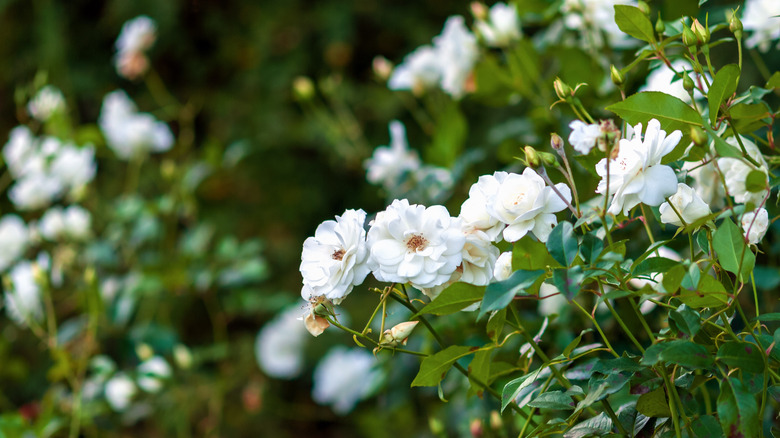
Nadya So/Shutterstock
The award-winning iceberg (Rosa ‘Iceberg’) is quite the vigorous climber, reaching 15 feet. It’s a remontant rose that produces glossy leaves and medium-sized, double white flowers that occasionally have pink or green tints, per Gardeners’ World. As a medium climber, iceberg roses are perfect for pillars, arches, walls, fences, and the front of a house.
Bloom Season: Late spring, summer, and fall
USDA Growing Zone: 5 to 9
Growing Conditions: Full sun
Soil Type: Moist, well-draining soil
Size: 3 to 12 inches high, 2 to 3 inches wide
6. Parkdirektor riggers
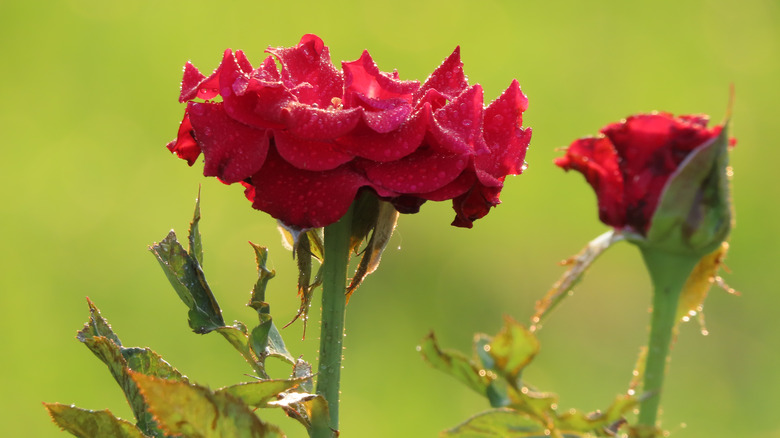
Thongthai/Shutterstock
Parkdirektor riggers (Rosa ‘Parkdirektor Riggers’) were hybridized by Kordes in 1957, according to Dave’s Garden. As one of the prettiest climbing roses, they are slightly fragrant and highly tolerant of shade, preferring the northern side of buildings. Parkdirektor riggers bears stunning foliage, which includes dark red blooms and glossy, dark green leaves.
Bloom Season: Late spring, early summer
USDA Growing Zone: 5 to 9
Growing Conditions: Full sun to partial shade
Soil Type: Well-draining; normal or moist; sandy loam, clay loam
Size: 12 to 18 inches high, 6 to 9 inches wide
7. Tangerine skies arborose
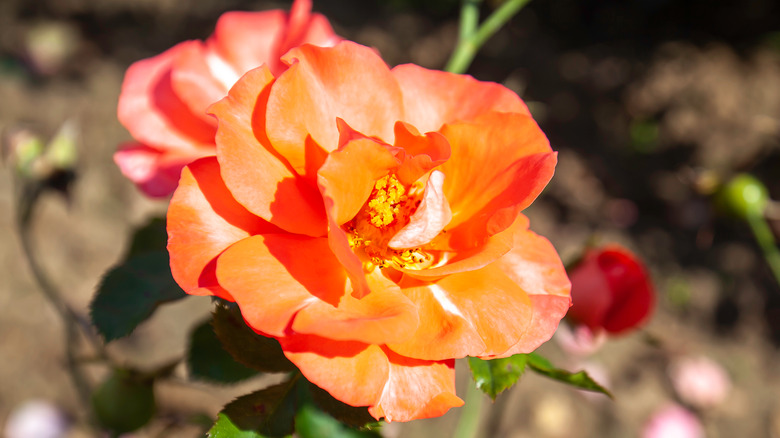
Jhve Photo/Shutterstock
Tangerine skies arborose (Rosa ‘KORtangenu’) has an unusual trait that makes it unique from other roses. Reports have it, per Nature Hills Nursery, that this striking rose flashes from peach to tangerine when sunlight directly shines on it. Opinions may differ, but we can all agree that it’s still stunning on a typical day. Tangerine skies arborose is a tall, climbing plant that produces bright, aromatic, orange flowers.
Bloom Season: Summer to mid-fall
USDA Growing Zone: 5 to 10
Growing Conditions: Full sun
Soil Type: Medium moisture, well-draining
Size: Up to 8 feet high, up to 4 feet wide
8. American beauty
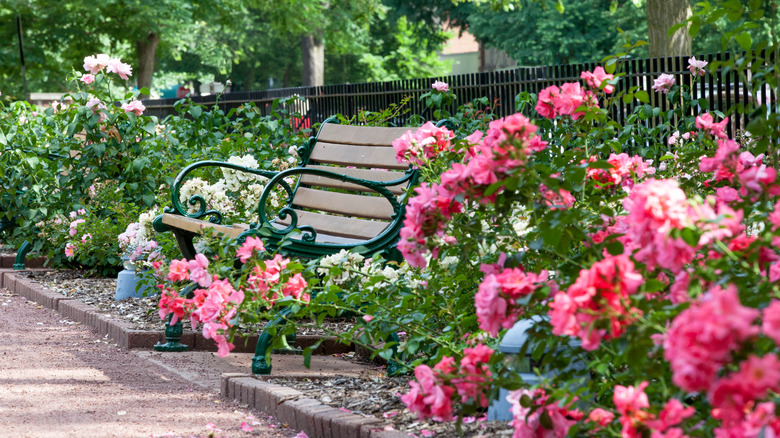
Deanna Oliva Kelly/Shutterstock
As one of the most stunning climbing roses to thrive in cold climates, American beauty (Rosa ‘American Beauty’) couldn’t have been more aptly named. It’s a cultivar bred in France by Henri Lédéchaux in 1875, and it is adored for its deep, cupped pink blooms. American beauty is not only shade-tolerant, but also features long canes that make training easy, via The Spruce.
Bloom Season: Spring to fall
USDA Growing Zone: 5 to 9
Growing Conditions: Full sun to partial shade
Soil Type: Well-draining, moderately moist
Size: 12 to 15 feet tall, 2 to 3 feet wide
9. Claire Austin
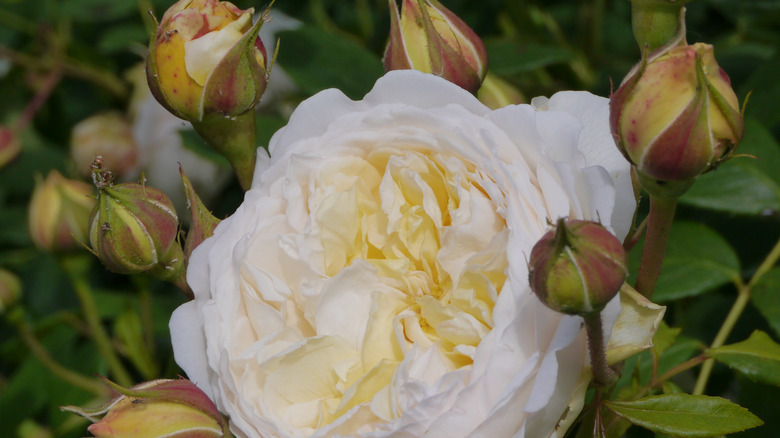
John R. Martin/Shutterstock
Claire Austin (Rosa ‘Claire Austin’) is a short climbing rose that homeowners adore for its stunning foliage. It has creamy-white flowers, rich-green leaves, and a heavenly fragrance. According to Gardenia, Claire Austin is deciduous, repeat-flowering, disease-resistant, and smells like myrrh and vanilla. You’ll love how it can upgrade your garden when you train it against a pergola, wall, or large arch.
Bloom Season: Summer to fall
USDA Growing Zone: 5 to 9
Growing Conditions: Full sun to partial shade
Soil Type: Fertile, moist, well-draining
Size: Up to 4 feet tall, 2 to 3 feet wide
10. Zephirine drouhin
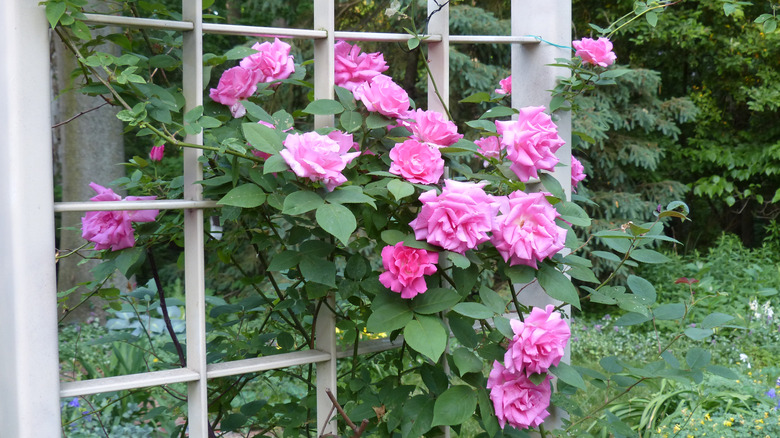
Lflorot/Shutterstock
Zephirine drouhin (Rosa ‘Zephirine Drouhin’) is one of the few climbing roses that’s nearly thornless and low-maintenance. Although it’s an old-fashioned rose, it outperforms most modern climbers with its long bloom, tolerance, and stunning beauty. And according to Jackson & Perkins, zephirine drouhin also bears raspberry scented, double-pink flowers, which will add fragrance to your yard. Pro tip: Train it against fences or trellis to improve air circulation.
Bloom Season: Late spring to summer
USDA Growing Zone: 5 to 9
Growing Conditions: Full sun, part shade; north-facing walls
Soil Type: moist, well-drained, loamy soil
Size: 15 to 20 feet high, 4 to 6 feet wide
11. Don Juan
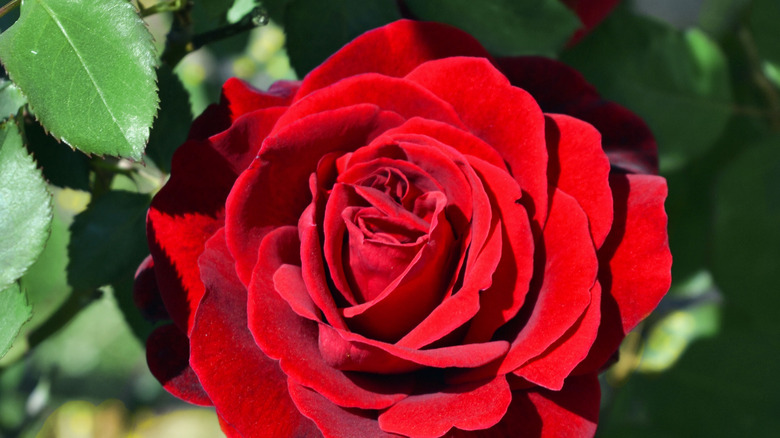
MaryAnne Campbell/Shutterstock
Known as the rose of lovers, Don Juan (Rosa ‘Don Juan’) is a climbing, hybrid tea rose introduced by Malandrone in 1958, as noted by Dave’s Garden. It produces scores of large, dark-crimson flowers and has about 40 perfumed petals per bloom. Don Juan is vigorous and conspicuous, painting walls, fences, and other structures with romance and life. It also makes excellent cut flowers.
Bloom Season: Summer through fall
USDA Growing Zone: 5 to 9
Growing Conditions: Full sun
Soil Type: Rich, well-draining, fertile, moist
Size: 12 to 14 feet tall, 3 to 6 feet wide
12. Compassion
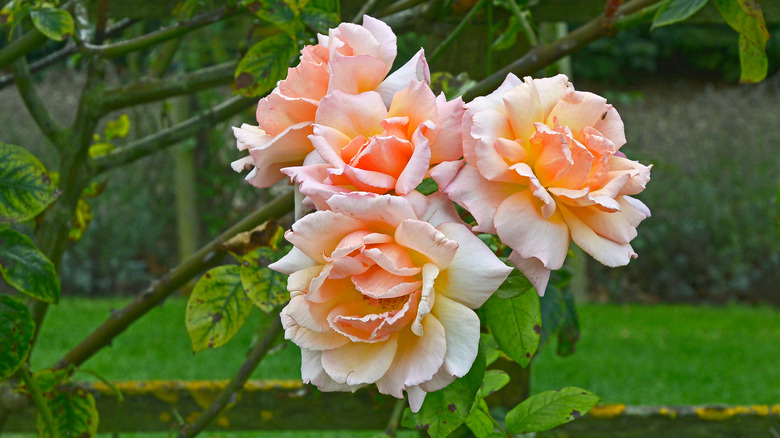
Gardens by Design/Shutterstock
If you plant compassion (Rosa ‘Compassion’) when the ground is not frozen or wet, you will enjoy a magnificent floral display throughout the summer. It was bred by Harkness in 1972 and known to work well with hybridized dahlias, per Gardeners’ World. Compassion is one of the most striking climbing roses, offering highly fragrant, double coral-pink blooms.
Bloom Season: Late spring to late summer
USDA Growing Zone: 5 to 10
Growing Conditions: Full sun
Soil Type: Well draining, rich, fertile, adequately moist
Size: 5 to 15 feet tall, 5 to 8 feet wide
13. Cécile brunner
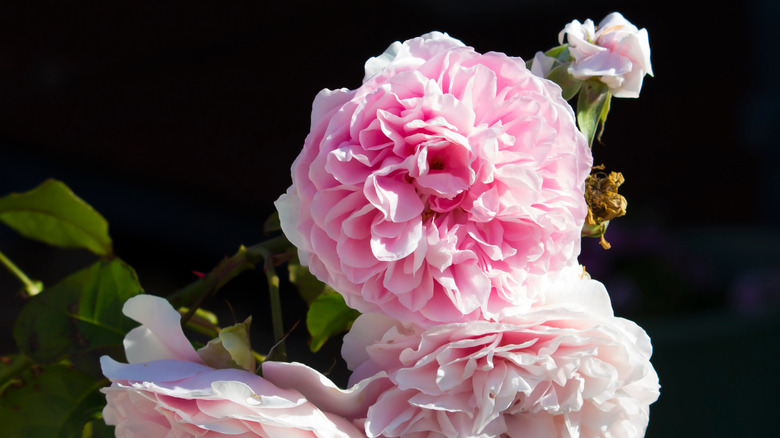
Alybaba/Shutterstock
If you meet the needs of Cécile brunner (Rosa ‘Cécile Brunner’), she’ll become an impressive 10-foot giant in one season, Monrovia says. As a homeowner, you’ll want this thornless climber in your country garden, which you can train over trellises, arches, fences, or north-facing walls. Cécile brunner bears sweet-scented, light pink flowers.
Bloom Season: Late spring, early summer
USDA Growing Zone: 5 to 9
Growing Conditions: Full sun to partial shade
Soil Type: Well-draining, moist, fertile, humus-rich
Size: 10 to 20 feet tall, 3 to 6 feet wide
14. A shropshire lad
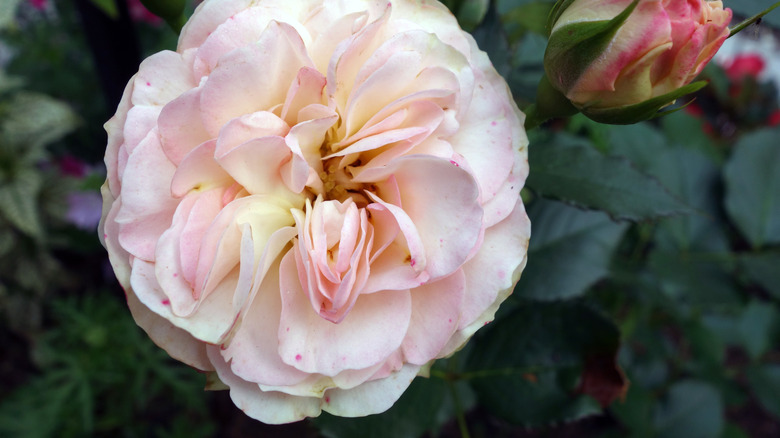
Sokol Nina/Shutterstock
For the perfect floral arrangement, introduce a Shropshire lad rose (Rosa ‘A Shropshire Lad’) to your landscape. It’s an excellent repeat bloomer that produces large blossoms and up to 100 peach-pink rosettes. According to David Austin, the breeder, the rose was introduced in 1996 and had a tea-like scent. Austin is known best for combining the perfumes of old roses and other flower forms to create exquisite modern roses.
Bloom Season: Late spring to winter
USDA Growing Zone: 5 to 9
Growing Conditions: Full sun to partial shade
Soil Type: Well-draining, rich, fertile, moist
Size: Up to 8 feet tall, up to 5 feet wide
15. Dublin Bay
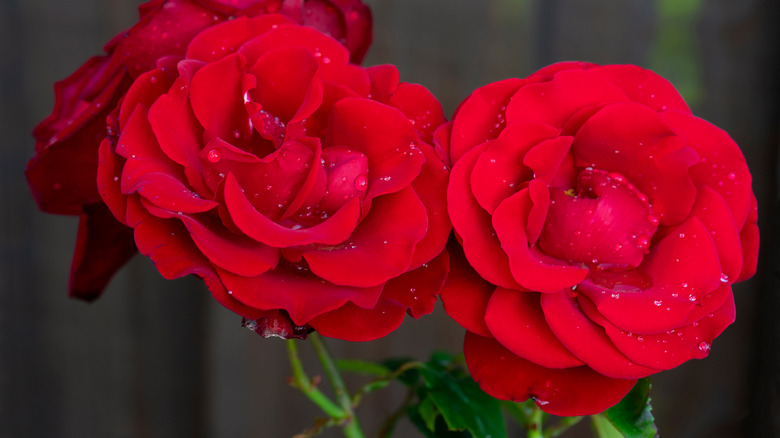
Ann in the UK/Shutterstock
Here we have Dublin Bay (Rosa ‘Dublin Bay’), the sun-loving rose that bears medium to large foliage. It’s best known for producing dark, glossy green leaves and fully-double, red flowers. There’s a mild, fruity fragrance to this rose that’s just so captivating. For repeat-flowering Dublin Bays, choose an area that receives full sun, says Peter Beales Roses.
Bloom Season: Summer, fall
USDA Growing Zone: 6 to 9
Growing Conditions: Full sun
Soil Type: Moist, well-draining
Size: 8 to 20 feet tall, 4 to 5 feet wide
16. Bridge of Sighs
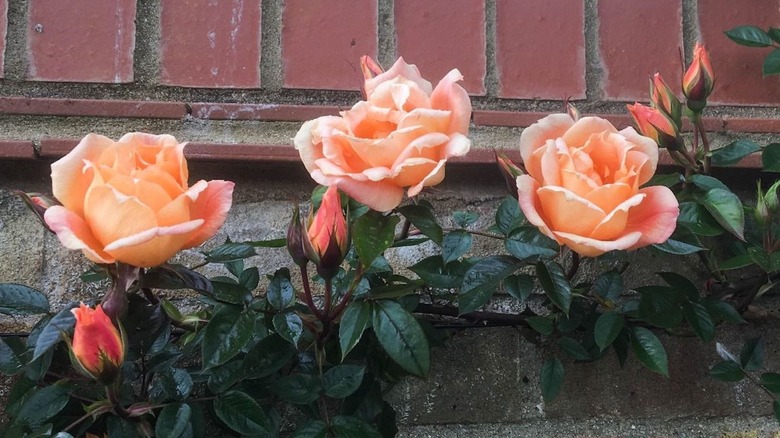
The Fragrant Rose Company
The Bridge of Sighs (Rosa ‘Bridge of Sighs’), also known as Rosa Harglowing, is a brilliant rose hybrid that blooms in an apricot orange color. This type of rose was developed alongside many other flowers, including the Alexander, Mountbatten, and Amber Queen. The Bridge of Sighs is remarkable for its flowers, forming clusters of three to seven, making them colorful additions to gardens and landscapes. These climbing vines have deep green leaves throughout the summer and give off fragrant smells. However, they are deciduous perennials, meaning they shed their foliage and go dormant during the winter months. Many people use these flowers to adorn outer walls and fences, as their vines can grow almost double an average person’s height.
Bloom Season: Late spring to early summer
USDA Growing Zone: 6 to 9
Growing Conditions: Full sun
Soil Type: Neutral to mildly acidic
Size: 8 to 10 feet high, up to 10 feet wide
17. Eden Climber
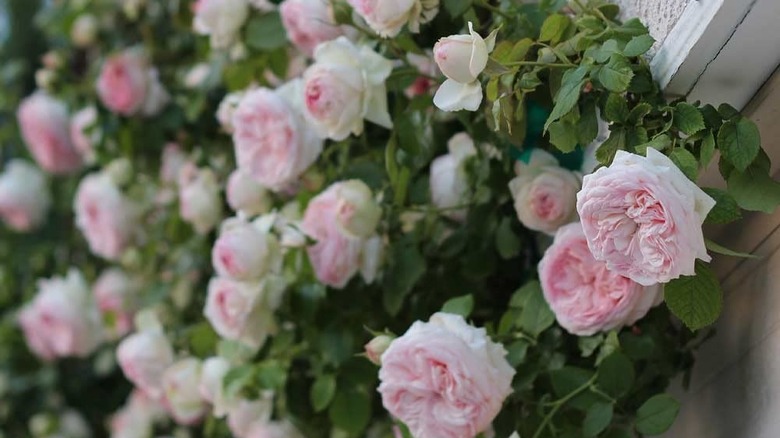
Amazon
The Eden Climber (Rosa ‘Eden’) was named 2006’s World’s Favorite Rose by the World Federation of Rose Society. This cultivar is free-blooming and famed for its repeated blossoming throughout the year. The petals range from shades of pale pink to cream, and depending on the rose supplier, there are about 40 to 100 petals per flower. Although the fragrance from these shrubs isn’t as strong as other roses, Eden Climbers still have a faint classic scent that rose aficionados appreciate. Their aroma also attracts butterflies, which are welcomed creatures under typical circumstances. Many homeowners grow these flowers up arches, pillars, and building facades, as their pastel colors make elegant accents for most architectural designs.
Bloom Season: Late spring to early fall
USDA Growing Zone: 4 to 9
Growing Conditions: Full sun to partial shade
Soil Type: Well-draining, loamy and chalky, neutral to acidic
Size: 5 to 10 feet high, 5 to 6 feet wide
18. Peggy Martin
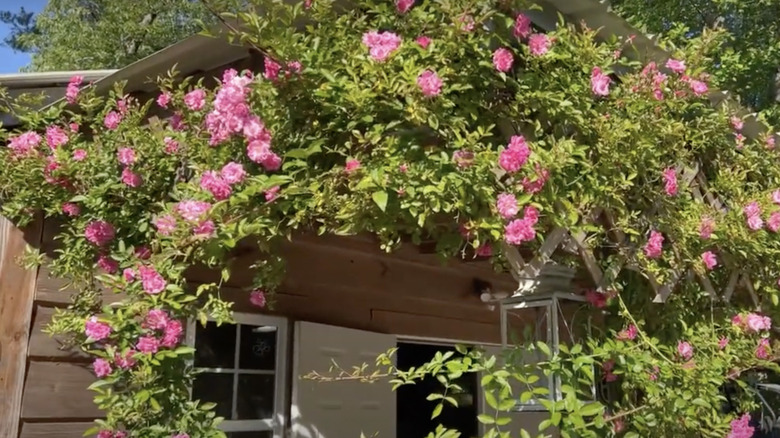
YouTube
With woody vines and vibrant pink flowers, Peggy Martins (Rosa ‘Peggy Martin’) are well-known to gardeners as classic Southern roses. They’re revered for being incredibly resilient and have even been dubbed the “Hurricane Katrina Roses.” When the infamous and devastating hurricane struck Louisiana in 2006, a cluster of these climbing roses managed to survive despite being submerged in saltwater. The cuttings have since then been cultivated and sold to fund hurricane restoration projects and beautify landscapes across the southern United States. The moderate fragrance and bold colors make for thriving plants that can be grown on trellises, poles, arches, pillars, fences, and walls, or they can be left alone to spread on their own.
Bloom Season: Late spring to early summer
USDA Growing Zone: 4 to 9
Growing Conditions: Full sun
Soil Type: Moist but well-draining, slightly acidic
Size: Over 6 feet high, over 6 feet wide
19. Joseph’s Coat
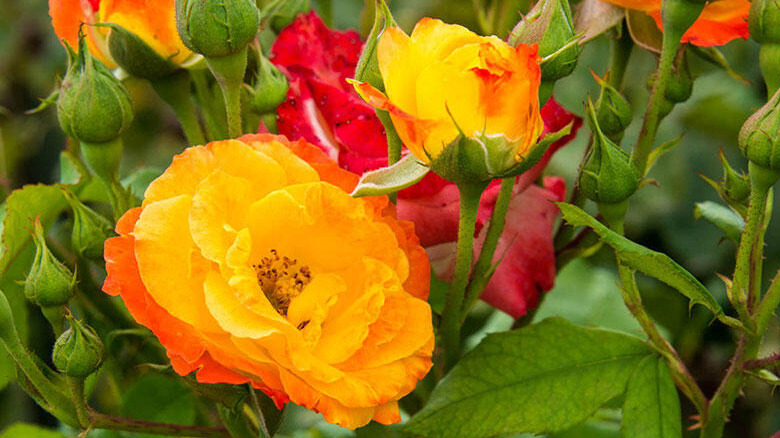
Lowe’s
Joseph’s Coats (Rosa ‘Joseph’s Coat’) are ombre-style climbing roses featuring reds, pinks, oranges, and yellows across their petals. These multi-colored shrubs can be maintained as bushes or grown into large hedges, as they are upright and hardy blooming plants. They have deep green leaves and give off a slight fragrance that attracts bees. These are helpful visitors in any garden as they provide natural pollination, and they can potentially help your roses thrive as late as November. Many homeowners adore these climbers since they double their size quickly and bloom within two months of planting in warmer climates. Since they are easy to grow and disease-resistant, they are common finds at corporate gardening chains and local nurseries alike.
Bloom Season: Spring to early fall
USDA Growing Zone: 6-10
Growing Conditions: Full sun to partial shade
Soil Type: Fertile, loamy, well-draining
Size: 8 to 12 feet high, 6 feet wide
20. Souvenir de la Malmaison
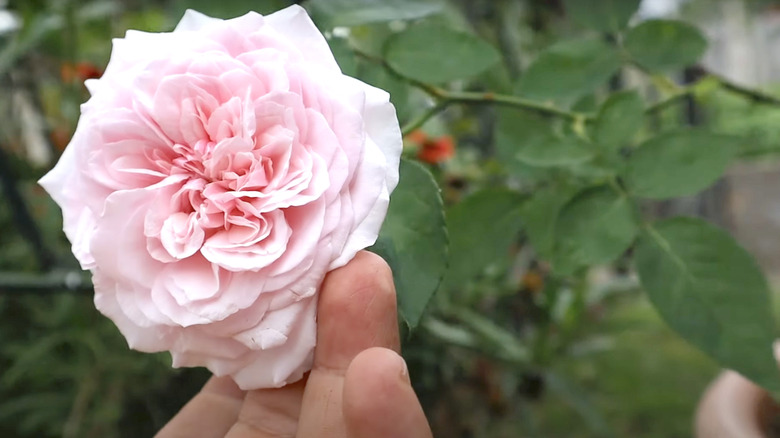
YouTube
The Souvenir de la Malmaison (Rosa ‘Souvenir de la Malmaison’) has a billowing appearance with pale pink petals, and they sport a different look than traditional rose flower styles. These shrubs are the climbing form of the well-known Bourbon Rose, giving off a distinct sweet and fruity fragrance. They’re ideal for tall walls and fencelines, where their swirling petals can unfurl to their full potential undisturbed. Although they are a particularly gorgeous type of rose, these flowers have a soft composition that is susceptible to hard rain and wind, making them better suited for areas with some protection from the natural elements.
Bloom Season: Spring to fall
USDA Growing Zone: 5 to 9 (Note: plant holds up better in drier climates)
Growing Conditions: Full sun to partial shade
Soil Type: Fertile, all types, mildly acidic to mildly alkaline
Size: Up to 3 feet high, up to 3 feet wide
21. Mortimer Sackler (Mary Delaney)
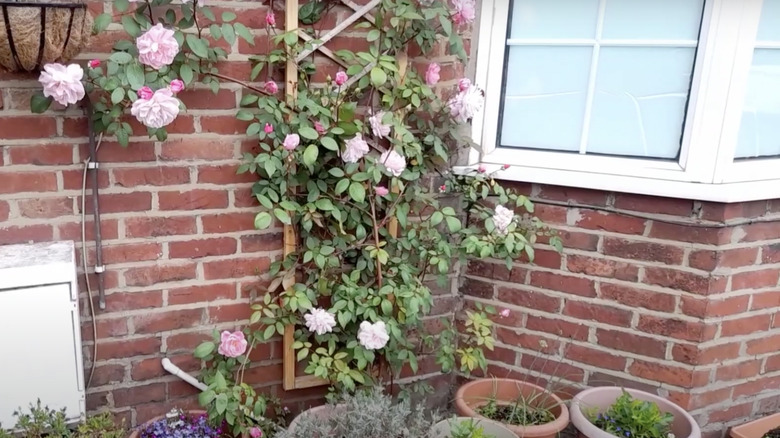
YouTube
If you’re looking for a rose that thrives in south or west-facing positions, the Mortimer Sackler/Mary Delaney (Rosa ‘Mortimer Sackler’) is a deciduous shrub with two-toned pink blooms. This climbing rose’s name has recently changed from Mortimer Sackler to Mary Delaney, and not all nurseries have updated their stock to show this change. As for the plants themselves, many gardeners are smitten by the colorful stems, which range from red to green to form a gorgeous flowering vine. The stems are primarily thornless, and their flowers open wide to reveal a yellow center during their peak season. They grow thick enough to be bush-like, making these climbing roses popular for flower beds, garden borders, and landscape hedges. While in bloom, they give off a faint classic rose fragrance.
Bloom Season: Spring to summer
USDA Growing Zone: 4 to 9
Growing Conditions: Full sun to partial shade, sheltered
Soil Type: Sandy to chalky, fertile, moist
Size: Up to 10 feet high, 3 feet wide
22. Lady Banks
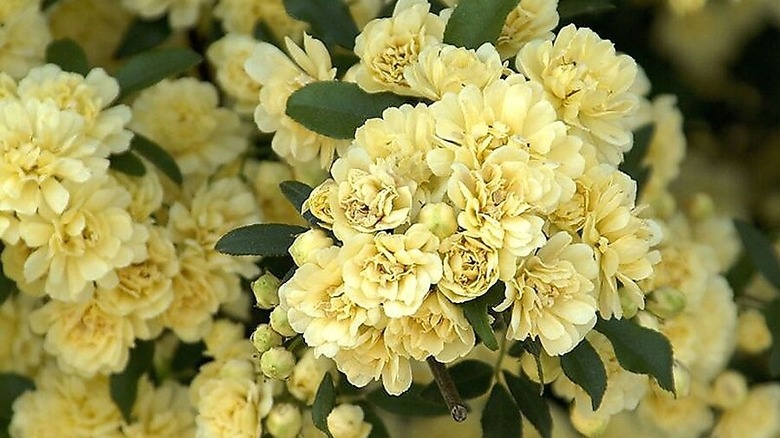
Lowe’s
Although they were originally cultivated in central and western China in the 19th century, the Lady Banks (Rosa banksiae) have since made their way to the United States. These light yellow roses are mostly thornless, making them safer to handle than most rose cultivars. Only the strongest-growing stems tend to grow spikes, meaning successful gardeners should be cautious but not overly worried about pricking their fingers. They climb up fences, rocks, and walls, making them great additions to natural gardens and constructed buildings alike. Documented searches have come to the conclusion that these shrubs are no longer found in nature, but modern gardening keeps their existence alive and plentiful.
Bloom Season: Spring to early summer
USDA Growing Zone: 6 to 8
Growing Conditions: Full sun, tolerates light shade
Soil Type: Well-draining, moderately fertile, chalky, loamy and sandy, neutral to acidic
Size: 15 to 20 feet high, 5 feet wide

